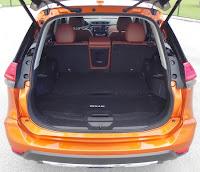2018 NISSAN ROGUE CROSSOVER GETS PROPILOT TECHNOLOGY FOR SL MODELS
Nissan followed up its redesign of its popular Rogue crossover with several midyear enhancements 2017, and the updates keep coming for 2018 with added technology that represents a step — albeit a baby one — to self-driving capability.
The system, dubbed ProPilot, is available on the top trim Rogue SL model as part of a $790 Platinum Package suite of features that also includes 19-inch wheels (replacing standard 18-inchers) and an electronic parking brake.
To activate ProPilot assist technology, you simply push a button on the right side of the steering wheel spoke, then set the desired speed for the adaptive cruise control for the system to kick in.
In addition to keeping your Rogue at a proper distance from the vehicle in front of you, ProPilot also gently helps keep you in your proper lane via a camera-based system that works in a variety of conditions.
Frankly, the technology isn’t all that ground-breaking. I have driven many vehicles that give you a warning, either by an annoying buzzer or by gently vibrating the driver’s seat, to let you know if you are drifting out of your lane, and even been in some will give your steering wheel a nudge to keep you aligned properly.
Those, however, were a bit too aggressive, and even ProPilot takes a bit of getting used to.
Probably the most important thing to note about the ProPilot Assist is the the word "assist." It does not turn the Rogue (or the Leaf) into a self-driving car.
You still must perform basic functions, like keeping your hands on the steering wheel and keeping track of traffic around you. You can’t haul out your cell phone and start dialing calls (though you can I guess if you have synced your phone through the Bluetooth system).
Frankly, other than the adaptive cruise control, I’m not sure I would opt to include ProPilot among the options I would pay extra for, especially with adaptive cruise control and lane departure warning now standard on the SL, but it's not like the cost runs into four figures.
It’s kind of like off-road capability. Even if you don’t use it, it’s nice to know it’s there.
Other changes to the Rogue for 2018 are NissanConnect with Apple CarPlay and Android Auto and an additional USB port to all trim levels (S, SV, and SL) and standard Intelligent Cruise Control, Lane Departure Warning, Intelligent Lane Intervention and Automatic Emergency Braking with Pedestrian Detection for the SL grade.
S and SV trims also get some revised features and colors.
All three are powered by a 2.5-liter, 4-cylinder engine that is rated at 170 horsepower and 175 pound-feet of torque and mated with — dare we say it? — a continuously variable transmission.
Those are good figures and, according to the government, you will spend zero, yes zero, more dollars on fuel costs over a five-year period for the Rogue over other compact crossovers/SUVs.
But, thanks to that CVT, the fun driving quotient is very low.
The Rogue’s other qualities, however, weigh heavily in its favor.
The cabin design is very pleasing to the eye and the materials first-rate. Put an analog clock in the middle of the center stack and slap on Infiniti badging and it very easily could match up to offerings from its upscale siblings.
Price for the Rogue starts at $25,395 (including $975 destination and delivery) for front-wheel-drive S models. The SL with all-wheel drive starts at $33,385, and the SV trims sit in between. Hybrid models start at $27,615 for FWD and go up to $38,885 for SL models with AWD.
What I liked about the 2018 Nissan Rogue SL: The well-trimmed cabin is roomy and comfortable, and there's nice storage space (39.3 cubic feet) in the back with the elimination of the third row seating. The technology is plentiful and user friendly, especially for us non-geeks. And the exterior appearance doesn't take a backseat to any other vehicle.
What I didn't like about the 2018 Nissan Rogue SL: Nissan has refined the CVT to a fine point, but there is one thing it can't get away from. It's still a CVT. Whatever the engine might deliver in the way of performance, the CVT takes away from it.
Would I buy the 2018 Nissan Rogue SL? I basically have struck two vehicle types off my list of potential purchases: Plugin hybrids and vehicles with CVTs. Thankfully, this isn’t a plugin. If those features don't bother you, and you don't care about sporty performance in a crossover, then yes, the Rogue is a good choice. I might even overlook that it has a CVT next time I go vehicle shopping.










No comments:
Post a Comment